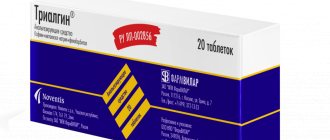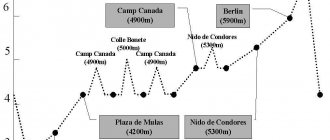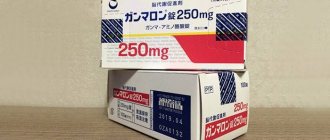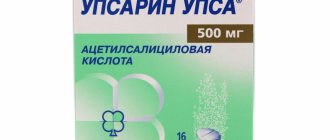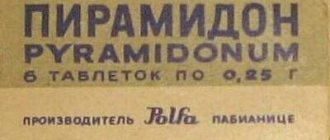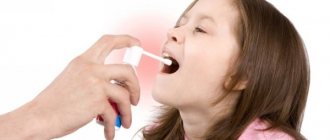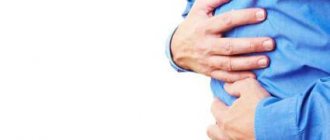Throughout life, a person repeatedly experiences abdominal pain. Under the age of 50, most often the cause of pain is not organic, but functional in nature, when drug therapy is most likely to be effective. The cause may be intestinal colic (in children in the first months of life), irritable bowel syndrome, biliary dyskinesia, dysfunction of the sphincter of Oddi, etc. About a third of cases of functional pain are accompanied by spasm of the smooth muscles of the gastrointestinal tract. This is why antispasmodics are so widely used without a doctor’s prescription. Providing a pronounced analgesic effect and normalizing the functioning of the organ, they, unlike non-narcotic and opioid analgesics, do not interfere with the mechanisms of pain, that is, they do not “erase” the picture of the disease, which is critically important in diagnosis.
Nota bene!
When a client asks for a remedy for abdominal pain, it is necessary to exclude urgent situations in order to send the sufferer to a doctor in time. These include:
- Severe pain that prevents you from sleeping or doing anything, lasts longer than 1-2 hours.
- Severe abdominal pain is accompanied by vomiting.
- Severe pain is accompanied by elevated body temperature - 38.5°C and above.
- Severe pain is accompanied by loss of consciousness.
- Severe abdominal pain in a pregnant woman.
- The abdominal muscles are tense and the stomach is as hard as a board.
- Diarrhea mixed with bright red blood.
- The stool is dark and tarry.
- Vomiting blood.
- Abdominal pain is accompanied by vomiting, diarrhea and severe dehydration.
Cellular mechanism of pain
Smooth muscle cells are mainly found in the large intestine. There are significantly fewer of them in the small intestine. The mechanism of cell contraction depends on the concentration of calcium ions in the cytoplasm. The sources of calcium are the extracellular space, connected to the cytoplasm through calcium (slow) membrane channels, as well as the intracellular depot. The release of calcium causes the muscle cell to contract. The contraction of muscle cells forms a spasm and the person feels pain.
The process of muscle contraction is most often triggered by the mediator acetylcholine, binding to muscarinic cholinergic receptors (M-cholinergic receptors). Thus, blockade of M-cholinergic receptors leads to a decrease in tone and relaxation of smooth muscles (and therefore helps relieve abdominal pain). This, in particular, is the basis for the mechanism of action of a group of drugs called M-anticholinergics.
The interaction of calcium with calmodulin leads to the interaction of actin with myosin and cell contraction. CAMP (cyclic adenosine monophosphate) and cGMP (cyclic guanosine monophosphate) weaken the interaction of calcium with calmodulin and also impede the entry of calcium ions into the cell. The level of cAMP and cGMP is controlled by phosphodiesterase (PDE), which destroys excess of these nucleotides. Thus, if you reduce the activity of PDE, the concentration of calcium ions in the cytoplasm will decrease and the tone of the muscle cell will decrease.
Based on the described mechanisms for regulating the calcium concentration inside the muscle cell, which are disrupted under pathological conditions and lead to spasm, the main groups of antispasmodics have been created:
- M-anticholinergics (atropine, hyoscine butyl bromide).
- PDE IV inhibitors (drotaverine).
- Blockers of calcium release from intracellular stores or sodium channel blockers (mebeverine).
- Calcium channel blockers.
Pharmacological action and its mechanism
Antispasmodic drugs can eliminate spasms through two mechanisms. The first mechanism is that the drug binds to the same receptor on smooth muscle as the neurotransmitter acetylcholine, but does not activate the receptor, but blocks it by simply occupying the acetylcholine site. The excess amount of acetylcholine cannot interact with its receptors, and the smooth muscle relaxes. This action is a neurotropic antispasmodic effect. Neurotropic because it affects the autonomic nervous system, making its activity ineffective.
The second mechanism by which antispasmodics can act is through the penetration of the drug into the smooth muscle cell, which changes its contractile physiology and makes its contraction ineffective. In this case, an antispasmodic effect will develop. This type of action is called the myotropic antispasmodic effect of gr. myos muscle and thropos direction of action.
Antispasmodics are classified according to the mechanism of action indicated above, since the mechanism of action is associated with well-predicted therapeutic and side effects.
M-anticholinergics
M-anticholinergics are one of the oldest groups of drugs.
Atropine has been used in medicinal herbs since the 4th century BC. e. Thus, the ancient Greek naturalist Theophrastus described mandrake as a remedy for treating wounds, gout and insomnia, and also as a “love potion.” The ancient Greek military physician Dioscorides (1st century AD) described mandrake wine as an anesthetic to treat pain or insomnia, to be given before surgery or cauterization. M-anticholinergics most effectively affect the upper gastrointestinal tract. The use of non-selective M-anticholinergics (atropine, platyphylline, metacin) is limited by their prescription, as well as by the fact that they have a systemic effect and have a number of side effects, such as intestinal atony and obstruction.
One of the relatively oldest selective M-anticholinergics is hyoscine butyl bromide (first registered in Germany in 1951). It acts on the M1 and M3 subtypes of receptors, localized mainly in the walls of the upper gastrointestinal tract, gallbladder and biliary ducts. Hyoscine butyl bromide does not penetrate the blood-brain barrier and has a weak systemic effect, unlike atropine. However, it is contraindicated in people with glaucoma, benign prostatic hyperplasia, as well as organic stenosis of the gastrointestinal tract and tachyarrhythmias. Hyoscine butyl bromide accumulates in the smooth muscles of the gastrointestinal tract and is excreted unchanged by the kidneys. The drug is successfully used for sphincter of Oddi dysfunction, biliary dyskinesia and pyloric spasm.
The severity of the effect of hyoscine butylbromide also depends on the patient’s individual sensitivity to this drug. Unfortunately, the antispasmodic effect of hyoscine butyl bromide on the small intestine (except the duodenum) and large intestine can be realized when taking a dose 2–10 times higher than the therapeutic dose, so its use is useless for spasms in the lower abdomen. A large number of restrictions and risks when taking this drug require medical supervision, which is why the M-anticholinergics known to us are currently used less and less abroad. However, hyoscine butyl bromide is still available without a prescription.
Basics of therapy and application features
Not all antispasmodics have the same effect on certain organs. Some of them act predominantly on smooth muscles in some organs, and have no or almost no effect on smooth muscles in other organs. This selectivity of action is called selectivity.
For example, atropine, belladonna extract, papaverine and drotaverine, universal antispasmodics, bendazole acts primarily on blood vessels, theophylline primarily on the bronchi, mebeverine and prifinium bromide primarily on the organs of the gastrointestinal tract. Depending on the direction of action of the antispasmodic, it is prescribed for a particular pathology.
Neurotropic and myotropic antispasmodics, despite the fact that both relieve spasms of internal organs, they have common positive and negative aspects. For example, neurotropic antispasmodics cause dry mucous membranes and may cause constipation. Myotropic antispasmodics do not have such side effects, but they dilate blood vessels and lower blood pressure. Because of this, they are prescribed with caution to people with low blood pressure, or they may be contraindicated for them. Patients receiving medications for high blood pressure may require dose adjustment of antihypertensive drugs when prescribed a myotropic antispasmodic. Neurotropic antispasmodics do not have such disadvantages.
A positive feature of antispasmodics is their inability to mask threatening symptoms in the abdominal area, unlike analgesics. This means that if there is a serious pathology of the abdominal cavity, for example, inflammation of the peritoneum, the use of an antispasmodic will not mask this condition. The pain will persist despite the use of an antispasmodic. In this case, it is necessary to urgently seek medical help.
In any case, antispasmodic drugs can only be used after consulting a doctor, or if the drug is over-the-counter, after consulting a pharmacist.
Phosphodiesterase inhibitors (PDE) type IV
These are traditionally widely used antispasmodics: drotaverine hydrochloride and papaverine. Their injectable forms are sold with a prescription, while their tablet forms are available without a prescription. PDE IV is widely present in smooth muscle along the entire length of the intestine, as well as in the biliary and urinary tracts. Thus, blocking PDE IV has a universal antispasmodic effect regardless of the severity of the spasm or its cause. In addition, drotaverine has anti-edematous and anti-inflammatory effects. Drotaverine can be used for acute abdominal pain - both to relieve acute spasms and for long-term treatment of biliary dyskinesia, cholelithiasis, chronic intestinal diseases with spastic syndrome, which are accompanied by colicky or bursting pain. Unlike M-anticholinergics, drotaverine can be used in elderly men with prostate pathology, as well as with concomitant pathology and combined use with other drugs. The therapeutic concentration of drotaverine in plasma when taken orally is achieved after 45 minutes.
Antispasmodic drugs
Home Medical encyclopedia Medicines Cardiovascular medicines
AKABEL
A combined drug containing an antispasmodic (an agent that relieves spasms) bevonium methyl sulfate and a non-narcotic analgesic analgin.
Pharmachologic effect. It has broncho- and antispasmodic properties (expands the lumen of the bronchi and relieves spasms).
Indications for use. Bronchial asthma, bronchospastic syndrome (narrowing of the bronchial lumen), peptic ulcer of the stomach and duodenum, pylorospasm (spasm of the muscles of the pylorus of the stomach), postoperative spastic pain, spastic constipation, cholestasis (stagnation of bile), cholangitis (inflammation of the bile ducts), postcholecystectomy syndrome (condition after surgery to remove the gallbladder), chronic hepatopathy (general name for liver diseases) and pancreatitis (inflammation of the pancreas), various diseases of the kidneys and urinary tract. Prenatal and postpartum pain, dysmenorrhea (menstrual cycle disorder), adnexitis (inflammation of the uterine appendages), endometritis (inflammation of the inner surface of the uterus), ovarian dysfunction, tumor of the genitals (genital organs).
Method of administration and dose. Akabel is prescribed orally 1-2 tablets 2-3 times a day, suppositories (adults only) - 1 suppository 2-3 times a day. Intramuscularly or intravenously, a l/i-ampule of Akabela is slowly administered 3 times a day.
Side effect. With intramuscular administration of the drug, transient local pain is possible. Long-term use causes dry mouth, increased heart rate, difficulty urinating, and dilated pupils.
Contraindications. Glaucoma (increased intraocular pressure), tachycardia (rapid heartbeat), adenoma (benign tumor) of the prostate, organic stenosis (narrowing of the lumen) of the gastrointestinal tract, megacolon (significant dilation of part or all of the colon), antidepressant therapy. Allergy to pyrazolone derivatives, with granulocytopenia (decreased granulocyte content in the blood). Subcutaneous and intra-arterial administration of the drug should be avoided, as well as use during pregnancy, especially in the first 3 months.
Release form. Tablets containing bevonium methyl sulfate 0.05 g, analgin 0.25 g; candles containing
bevonium methyl sulfate 0.03 g, analgin 1 g; ampoules of 5 ml containing bevonium methyl sulfate 0.0025 g, analgin 2.5 g.
Storage conditions. List B. In a dry place, protected from light.
ALPROSTADIL
Synonyms: Vazaprostan, Prostavazin, Minprog, Prostandin, Prostin VR.
Pharmachologic effect. A drug from the prostaglandin group (prostaglandin Ei). Causes a contraction of the muscles of the uterus, intestines and other smooth muscle organs, but at the same time has a pronounced peripheral vasodilator effect, increases blood flow in peripheral vessels, improves microcirculation, inhibits platelet aggregation (gluing) and has a disaggregation effect.
Indications for use. It is used mainly for chronic obliterating diseases of the lower extremities (inflammation of the inner lining of the arteries of the extremities with a decrease in their lumen / obliterating atherosclerosis, etc. The drug is more effective in stages II-III of ischemia (insufficient blood supply) of the lower extremities.
Method of administration and dose. Alprostadil is used intravenously and intra-arterially.
For intravenous use, the contents of 2 ampoules (40 mcg of the drug) are diluted in 250 ml of isotonic sodium chloride solution. Administered dropwise (over 2 hours) 1 time, in severe cases 2 times a day. If there is such a need, the dose is increased to 60 mcg (3 ampoules) and administered over 3 hours.
For intra-arterial administration, dilute 20 mcg (1 ampoule) in 50 ml of isotonic sodium chloride solution. First, 10 mcg ('/2 ampoules, i.e. 25 ml) is administered over 60-120 minutes; if well tolerated, 40 mcg can be administered in the future (during the same time). Injections are made 1-2 times a day. Long-term infusion through a catheter is possible.
The course of treatment lasts 15-25 days.
Side effect. When using alprostadil, a decrease in blood pressure, loss of appetite, diarrhea (diarrhea), dull pain in the limb being treated, a burning sensation, and redness at the site of catheter insertion are possible.
Contraindications. The drug is contraindicated during pregnancy and breastfeeding. It should be taken into account that
alprostadil enhances the effect of antihypertensive (lowering blood pressure) and antiaggregation (preventing platelet aggregation) agents.
Release form. In ampoules containing 0.02 mg (20 mcg) of alprostadil, 10 pieces per package.
Storage conditions. List B. In a dark place at room temperature.
ANDECALIN (Andecalinum)
Purified porcine pancreas extract that does not contain insulin.
Pharmachologic effect. Dilates peripheral blood vessels, lowers blood pressure.
Indications for use. Obliterating endarteritis (inflammation of the inner lining of the arteries of the extremities with a decrease in their lumen), Raynaud's disease (narrowing of the lumen of the vessels of the extremities), sluggishly healing wounds, spasms (sharp narrowing of the lumen) of cerebral vessels, circulatory disorders in the retina, scleroderma, the initial stages of hypertension ( persistent increase in blood pressure).
Method of administration and dose. Intramuscularly 1 time per day 10-40 units (depending on the severity of the condition) for 2-4 weeks; after a 2-3 month break, the course of treatment is repeated. Orally before meals, 2 tablets 3 times a day. After 6-10 days, the dose can be increased gradually to 9-12 tablets per day. Duration of treatment is 1 month. After a 2-3 month break, the course of treatment can be repeated.
Side effect. Allergic reactions.
Contraindications. Increased intracranial pressure, malignant neoplasms.
Release form. Lyophilized (dried by freezing under vacuum) andecalin for injection in bottles of 40 units complete with injection solvent; tablets of 15 units, film-coated, in a package of 50 pieces.
Storage conditions. The drug in dry (lyophilized form) is stored in a dry place at a temperature not exceeding +18 °C. When dissolved, it can be stored in a bottle for no longer than 3 days at a temperature of +5 °C; tablets - in a dry place at a temperature not exceeding +20 ° C.
BARALGIN (Baralginum)
Synonyms: Maksigan, Spazmalgon, Trigan, Spazgan.
A combined drug containing a non-narcotic analgesic analgin, an antispasmodic (a drug that relieves spasms) similar to papaverine, and a ganglion blocker.
Pharmachologic effect. It has a pronounced antispasmodic (relieving spasms) and analgesic effect.
Indications for use. Spasms of smooth muscles, especially renal colic, spasms of the ureters, bladder tenesmus (false painful urge to urinate), hepatic colic, spasms of the stomach and intestines, spastic dysmenorrhea (the general name for menstrual disorders that occur with pain).
Method of administration and dose. Orally, 1-2 tablets 3 times a day, in severe cases - intramuscularly or intravenously slowly.
Side effect. Allergic reactions are possible; with long-term use, granulocytopenia (a decrease in the content of granulocytes in the blood) requires discontinuation of the drug.
Contraindications. Granulocytopenia (decrease in the content of granulocytes in the blood), tachyarrhythmia (type
heart rhythm disturbances), coronary (cardiac) circulatory insufficiency, glaucoma (increased intraocular pressure), hypertrophy (increase in volume) of the prostate.
Release form. Tablets in a package of 20 pieces; ampoules of 5 ml in a package of 5 pieces.
Storage conditions. List B. In a dry place, protected from light.
HAWTHORN FRUITS AND FLOWERS (Fructus et Flores Crataegi)
The fruits contain flavonoids (hyperoside, quercetin, vitexin), ursolic and oleanolic acids, carotenoids, tannins, pectins, chlorogenic and caffeic acids, sugar. Flowers - flavonoids (quercetin, quercetin), essential oil, acetylcholine, choline, etc.
Pharmachologic effect. Hawthorn preparations increase the contraction of the heart muscle and reduce its excitability, improve blood circulation in the vessels of the heart and brain, and increase the sensitivity of the heart to the action of cardiac glycosides.
Indications for use. Functional disorders of the heart, hypertension (persistent rise in blood pressure), angioneurosis (impaired vascular tone), atrial fibrillation, paroxysmal tachycardia (heart rhythm disturbances).
Method of administration and dose. Orally 30 minutes before meals in the form of an infusion (1 teaspoon per glass of boiling water) - 1 tablespoon 2-3 times a day, tincture - 20 drops 3 times a day, liquid extract - 20-30 drops 3-4 once a day.
Release form. Fruits in a package of 50 g; tincture in 25 ml bottles; liquid extract in 25 ml bottles; flowers in a package of 100 g.
Storage conditions. In a dry, cool place.
Hawthorn extract is also included in the preparations Cardompin and Cardiovalen.
HALIDOR
Synonyms: Bencyclane fumarate, Bencyclamide.
Pharmachologic effect. Antispasmodic (relieving spasms) and vasodilator.
Indications for use. Endarteritis (inflammation of the inner lining of the arteries), thromboangiitis (inflammation of the artery wall with blockage), spasms (sharp narrowing of the lumen) of the brain vessels and coronary vessels (heart vessels), peptic ulcer, spasms of the urinary tract, cholecystitis (inflammation of the gallbladder).
Method of administration and dose. Orally 0.05-0.1 g 2-4 times a day, intramuscularly (if necessary intravenously) 1-2 ml of a 2.5% solution. The course of treatment is 15-20 days. For obliterating diseases of the arteries of the extremities (inflammation of the inner lining of the arteries of the extremities with a decrease in their lumen), treatment is effective mainly in stage II of the disease; administered intramuscularly (0.05 g 1-2 times a day for 15-20 days).
Side effect. Dyspeptic symptoms (digestive disorders), allergic reactions, dizziness, headache.
Contraindications. Severe circulatory and respiratory disorders.
Release form. Tablets of 0.1 g in a package of 50 pieces; ampoules of 2 ml of 2.5% solution in a package of 10 pieces.
Storage conditions. List B. In a dry place, protected from light.
GANGLERON (Gangleronum)
Synonyms: Ganglefen hydrochloride.
Pharmachologic effect. Blocks the N-cholinoreactive systems of the parasympathetic and sympathetic autonomic ganglia and the central nervous system.
has a myotropic antispasmodic (relieving spasms of smooth muscles), weak local irritant and anesthetic effect.
Indications for use. Angina pectoris, peptic ulcer of the stomach and duodenum, spastic dyskinesia (impaired mobility) of the gastrointestinal tract, etc.:
Method of administration and dose. Orally 0.04 g 3-4 times a day before meals; intramuscularly or subcutaneously, 1 ml of a 1.5% solution 3-4 times a day with a gradual increase in a single dose to 3 ml. The highest single dose for adults orally is 0.075 g, the daily dose is 0.3 g, the highest single dose subcutaneously and intramuscularly is 4 ml of a 1.5% solution, the daily dose is 12 ml of a 1.5% solution.
Side effect. Dizziness; upon contact with mucous membranes, a quickly passing sensation of irritation followed by anesthesia.
Release form. Capsules of 0.04 g in a package of 50 pieces; ampoules of 2 ml of 1.5% solution in a package of 10 pieces.
Storage conditions. List B. In a dry place, protected from light.
DATISCAN (Datiscanum)
It is a mixture of flavonoids, the main component of which is the glycoside datiscine. It is obtained from the Danish hemp herb.
Pharmachologic effect. Antispasmodic (a drug that relieves spasms).
Indications for use. Diseases of the gastrointestinal tract, accompanied by spasm of smooth muscles (muscles of blood vessels and internal organs).
Method of administration and dose. Orally 15 minutes before meals, 0.05-0.1 g 2-3 times a day daily for 10-20 days.
Side effect. Allergic reactions, headache, nausea, stomach pain, diarrhea.
Contraindications. Individual intolerance to the drug.
Release form. Tablets of 0.05 g in a package of 50 pieces.
Storage conditions. In a dry place, protected from light.
DIBAZOL (Dibazolum)
Synonyms: Bendazole, Bendazole hydrochloride, Tromasedan.
Pharmachologic effect. Vasodilator, antispasmodic (relieves spasms) and hypotensive (lowers blood pressure) agent.
Indications for use. Diseases accompanied by spasms of blood vessels (angina pectoris, hypertensive crisis /rapid and sharp rise in blood pressure/), smooth muscles of internal organs (peptic ulcer, spasms of the gastrointestinal tract), treatment of nervous diseases, mainly residual effects of poliomyelitis, peripheral paralysis of the facial nerve and etc.
Method of administration and dose. Take 0.02-0.05 g orally 2-3 times a day, usually for 3-4 weeks. or shorter courses. In the treatment of nervous diseases, dibazole is prescribed 5 to 10 times at a dose of 0.005 g (for adults) once a day or every other day. In 3-4 weeks. the course of treatment is repeated. Subsequent courses are carried out with a break of 1-2 months. Higher doses for adults orally: single - 0.05 g, daily - 0.15 g. Children are prescribed (for the treatment of diseases of the nervous system) in the following doses: up to 1 year - 0.001 g, 1-3 years 0.002 g, 4-8 years - 0.003 g, 9-12 years - 0.004 g, over 12 years -
0.005 g. If necessary, the course of treatment is repeated after 3-4 weeks. Dibazol is taken orally 2 hours before meals or 2 hours after meals.
Side effect. Dibazole is usually well tolerated. It is not advisable to prescribe the drug long-term as an antihypertensive drug to elderly patients, since the hypotensive effect is associated with a decrease in cardiac output and a possible deterioration in electrocardiogram parameters.
Release form. Tablets 0.02; 0.002; 0.003 and 0.004 g; 0.5% or 1% solution in ampoules of 1; 2 and 5 ml.
Storage conditions. List B. In a dry place, protected from light.
Dilminal
Synonyms: Dilminal-D.
A drug containing kallikrein.
Pharmachologic effect. Dilates blood vessels.
Indications for use. Diseases of peripheral vessels and associated trophic disorders: spastic forms of endarteritis (inflammation of the inner lining of the arteries of the extremities with a decrease in their lumen), Raynaud's disease (narrowing of the lumen of the vessels of the extremities), sluggishly healing wounds and ulcers.
Method of administration and dose. For mild forms of the disease, start with 2 tablets 3 times a day. The dose is selected individually. For more severe forms, 1 ampoule is administered deeply intramuscularly once a day. The drug is dissolved immediately before use. The course of treatment is 15-20 injections.
Side effects and contraindications are the same as for andecalin.
Release form. Dragees 2 units in a package of 20 pieces; ampoules (Dishinal D), containing 10 units, with the addition of a solvent, in a package of 10 pieces.
Storage conditions. List B. In a place protected from light.
DIPROPHEN (Diprophenum)
Pharmachologic effect. It has a vasodilator and weak anticholinergic effect.
Indications for use. Spasms (involuntary muscle contractions) of blood (especially peripheral) vessels (endarteritis /inflammation of the inner lining of the artery/, Raynaud's disease /narrowing of the lumen of the vessels of the extremities/, etc.), smooth muscles of internal organs (bronchial tubes, gastrointestinal tract, urinary tract).
Method of administration and dose. Orally 0.025 g 2 times a day with a gradual increase in dose to 0.05-0.1 g 3 times a day. The course of treatment is 2-3 weeks.
Side effect. Feeling of numbness of the oral mucosa, occasional nausea, headache, slight dizziness.
Release form. Tablets of 0.05 g in a package of 10 pieces.
Storage conditions. List B. In a well-closed container.
DIPROPHYLLINE (Diprophyllinum)
Synonyms: Aristofylline, Difillin, Isophylline, Astrophylline, Coronal, Coronarin, Corfillamine-Neutral, Diprofillina, Glifillin, Neutrafillin, Solufillin, Tefilan, Theophene, etc.
Pharmachologic effect. It has a coronary dilator (dilates the blood vessels of the heart) and bronchodilator (dilates the lumen of the bronchi) and slightly increases diuresis (volume of urine output).
Indications for use. Coronary spasm (narrowing of the lumen of the heart vessels), bronchospasm (narrowing of the lumen of the bronchi), arterial hypertension (persistent rise in blood pressure), hypertension.
Method of administration and dose. Prescribed orally, intravenously, intramuscularly. Inject intravenously (slowly!) 5-10 ml (for adults) of a 2.5% solution (diluted in aseptic/sterile/1 ampoule/5 ml/10% solution in 15 ml water for injection), intramuscularly - 3-5 ml 10 % solution 1-2 times a day. Take 0.2-0.5 g orally 3-4 times a day.
They are also used in the form of rectal suppositories containing 0.5 g of diprophylline. Inject 1 suppository into the rectum 1-2 times a day (morning and evening) after a preliminary cleansing enema or spontaneous bowel movement.
The course of treatment is usually 10-20 days. If necessary, the course is repeated after a 3-5 day break.
Contraindications. The use of diprophyllin, especially intravenously, is contraindicated in cases of sharply low blood pressure, paroxysmal tachycardia, extrasystole (heart rhythm disturbance), epilepsy. The drug should also not be used for heart failure, especially associated with myocardial infarction, when there is coronary insufficiency (a discrepancy between the heart's need for oxygen and its delivery) and heart rhythm disturbances.
Release form. Powder; tablets 0.2 g; 10% solution in ampoules of 5 ml; suppositories containing 0.5 g of the drug.
Storage conditions. List B. In a cool, dark place.
ANGISVDIN (Angisedin)
A combined drug containing diprophylline, peritrol triturate, caffeine, defenin hydrochloride, valerian extract, phenobarbital.
Pharmachologic effect. It has an antispasmodic (relieving spasms) and sedative (calming) effect, dilates the coronary (heart) vessels, stimulates contractions of the myocardium (heart muscle), increasing the output and cardiac output.
Indications for use. Chronic coronary insufficiency (mismatch between the heart's need for oxygen and its delivery), prevention of angina attacks, various types of cardialgia (pain in the left half of the chest).
Method of administration and dose. Prescribe 1 tablet 3 times a day after meals.
Release form. Tablets containing diprophylline 100 mg, peritrol triturate 12.5 mg, caffeine 50 mg, odefenine hydrochloride 15 mg, valerian extract 30 mg, phenobarbital 15 mg.
Storage conditions. List B. In a place protected from light.
KATASMA
A combined preparation containing diprophylline, sodium succinic acid, sodium guaiacol glycolate, caffamine brischettini.
The pharmacological action is due to the properties of its constituent components. Diprophylline has a bronchodilator effect, sodium succinic acid improves pulmonary ventilation, stimulating the respiratory center. Guaiacole derivatives have a drying, anti-catarrhal (anti-inflammatory) effect. Caffamine Brischettini (the original caffeine derivative) has respiratory analeptic properties.
Indications for use. Asthmatic bronchitis, phenomena of bronchospasm (sharp narrowing of the lumen of the bronchi)
for various pulmonary diseases, bronchial asthma, cor pulmonale.
Method of administration and dose. Prescribe from 1 to 3 ampoules per day intramuscularly or from 2 to 4 tablets per day.
Release form. Ampoules of 3 ml in a package of 10 pieces; tablets of 20 pieces per package. 1 ampoule contains 300 mg of diprophylline, 100 mg of sodium succinic acid, 100 mg of sodium guaiacol glycolate, 50 mg of Brischettini caffamine. 1 tablet contains 150 mg of diprophylline, 50 mg of sodium succinate, 100 mg of calcium guaiacol glycolate, 100 mg of Brischettini caffamine.
Storage conditions. List B. In a dry place, protected from light.
NAFTIDROFURIL (Naftidrofuril)
Synonyms: Duzodril, Cytoxide, Dubimax, Fuxaten, Iridax, Nafronil, Natiflux, Naftifurin, Praxylene, etc.
Pharmachologic effect. Refers to 5-HT2 serotonin receptor blockers. The drug dilates peripheral vessels (arteries), improves blood supply, oxygen supply to tissues, as well as blood circulation in the vessels of the brain, retina and other organs.
Indications for use. Prescribed for circulatory disorders in peripheral vessels, especially the lower extremities (intermittent claudication, Raynaud's disease, etc.), for trophic tissue disorders (bedsores, long-term non-healing ulcers, etc.), as well as for disorders of cerebral circulation, blood supply to the fundus and etc.
Method of administration and dose. Take per os (by mouth) 200-600 mg per day after meals. For acute vascular disorders, 100 mg is administered intramuscularly, intravenously or intraarterially 2-3 times a day, and then switch to long-term administration of the drug per os.
Side effect. When taken orally, loss of appetite, nausea, vomiting, diarrhea. With rapid intravenous and intra-arterial administration, some patients experience symptoms of agitation, less often depression (depressed state).
Contraindications. Acute myocardial infarction, tendency to hypotension (low blood pressure), acute hemorrhagic stroke (acute cerebrovascular accident as a result of rupture of cerebral vessels), increased convulsive readiness, severe heart failure, severe heart rhythm disturbances.
Release form. Dragee 0.06 g in packs of 20, 50, 100 and 600 pieces. Retard dragee (long-acting) 0.1 g in packs of 20.50, 100 and 600 pieces. Capsules of 0.2 g in a package of 20 pieces. Ampoules containing 0.2 g of naftidrofuryl, in packages of 5, 10, 20 or 100 pieces.
Storage conditions. List B. In a place protected from light.
NO-SPA (No-spa)
Synonyms: Drotaverine hydrochloride, Drotaverine, Deprolene, Dihydroetaverine, Nospan, Nospazin, Tetraspasmin.
Pharmachologic effect. It has a pronounced antispasmodic (relieving spasms) effect.
Indications for use. Spasm of the stomach and intestines, spastic constipation, attacks of cholelithiasis and urolithiasis, angina pectoris, spasm (sharp narrowing of the lumen) of peripheral vessels.
Method of administration and dose. Orally 0.04-0.08 g 2-3 times a day; intramuscularly 2-4 ml of 2% solution; intravenously (slowly) 2-4 ml of a 2% solution, if necessary intra-arterially (obliterating endarteritis /inflammation of the inner lining of the arteries of the extremities with a decrease in their lumen/).
Side effect. Dizziness, palpitations, sweating, feeling hot, allergic dermatitis (skin inflammation).
Contraindications. Hypertrophy (increase in volume) of the prostate gland and glaucoma (increased intraocular pressure), especially the angle-closure form.
Release form. Tablets of 0.04 g in a package of 100 pieces; ampoules with a capacity of 2 ml, containing 0.04 g, in a package of 50 pieces.
Storage conditions. List B. In a dry place, protected from light.
BISPAN
A combined drug containing no-shpu and the anticholinergic drug isopropamide.
Indications for use. Used for intestinal spasms, spastic colitis (inflammation of the colon, characterized by sharp contractions), acute and chronic hyperacid gastritis (inflammation of the stomach due to a persistent increase in acidity), peptic ulcer of the stomach and duodenum, cholecystopathy (gallbladder disease), spasms of the ureters and others diseases accompanied by spasms of smooth muscles of internal organs.
Method of administration and dose. Prescribed orally for adults in acute cases, 1-2 tablets 2-3 times a day; in chronic cases - 1 tablet 2-3 times a day for 3-4 weeks.
Side effects and contraindications are the same as for no-shpa
Storage conditions. List B. In a dry place, protected from light.
NICOSPAN (Nicospan)
A combined preparation containing no-shpa and nicotinic acid.
Pharmachologic effect. Has a pronounced vasodilating effect.
Indications for use. Spasms (sharp narrowing of the lumen) of cerebral and peripheral vessels.
Method of administration and dose. Orally after meals, 1 tablet 1-3 times a day or 1-2 ml ('/2-1 ampoule) subcutaneously or intramuscularly 1-2 times a day. If necessary, 1 ml of solution is injected slowly into a vein. For peripheral circulatory disorders (thromboangiitis obliterans), 1-2 ml of solution is injected (slowly!) into the femoral artery.
Side effects and contraindications are the same as for no-shpa.
Release form. Tablets of 0.1 g composition: no-shpa - 0.078 g, nicotinic acid - 0.0022 g; ampoules of 2 ml of the composition: no-shpa - 0.0642 g (64.2 mg) and nicotinic acid - 0.0176 g (17.6 mg), in a package of 10 pieces.
Storage conditions. List B - In a dry place, protected from light.
PAPAVERINA HYDROCHLORIDE (Papaverini hidrochloriduin)
Pharmachologic effect. Myotropic antispasmodic (relieving spasms of smooth muscles) drug. Reduces the tone and reduces the contractile activity of smooth muscles and therefore has a vasodilator and antispasmodic (relieving spasms) effect. In large doses, it reduces the excitability of the heart muscle and slows down intracardiac conduction.
Indications for use. Spasms (sharp narrowing of the lumen) of cerebral vessels, angina pectoris, endarteritis (inflammation of the inner lining of the arteries), cholecystitis (inflammation of the gallbladder), pylorospasm (spasm of the muscles of the pylorus), spastic colitis, spasm of the urinary tract, bronchospasm (narrowing of the lumen of the bronchi).
Method of administration and dose. Orally, adults take 0.04-0.08 g (40-80 mg) 3-4 times a day; children - also 3-4 times a day: from 6 months of age. up to 2 years - 0.005 g (5 mg) per dose, 3-4 years - 0.005-0.01 g, 5-6 years - 0.01 g, 7-9 years - 0.01-0.015 g , 10-14 years - 0.015-0.02 g per dose. In case of vomiting or difficulty swallowing, it is prescribed in the form of suppositories (suppositories) rectally (into the rectum) 0.02-0.04 g 2-3 times a day (for adults). Adults are administered 1-2 ml (usually 2 ml) of a 2% solution subcutaneously and intramuscularly, and intravenously in the same dose (very slowly!), diluting a 2% solution of papaverine hydrochloride in 10-20 ml of isotonic sodium chloride solution. Children are given in smaller doses according to their age. Higher doses for adults orally: single - 0.2 g, daily - 0.6 g; under the skin, intramuscularly and into a vein: single dose - 0.1 g, daily - 0.3 g. Higher doses for children orally from the age of 6 months. up to 1 year: one-time - 0.005 g, daily - 0.01 g; at the age of 2 years - one-time 0.01 g, daily 0.02 g; 3-4 years - one-time 0.015 g, daily 0.03 g; 5-6 years - one-time 0.02 g, daily 0.04 g; 7-9 years - one-time 0.03 g, daily 0.06 g; 10-14 years - one-time 0.05-0.06 g, daily 0.1-0.2 g. Children under 6 months. not prescribed.
Side effect. Atrioventricular block (impaired conduction of excitation through the conduction system of the heart), ventricular extrasystole (disturbance of heart rhythm), with intravenous administration, decreased blood pressure, constipation.
Contraindications. Atrioventricular conduction disorders (impaired conduction of excitation through the conduction system of the heart).
Release form. Powder; tablets of 0.01 g for children in a package of 10 pieces; tablets of 0.04 g in a package of 10 pieces; ampoules of 2 ml of 2% solution in a package of 10 pieces; rectal suppositories (suppositories for insertion into the rectum) 0.02 g in a package of 10 pieces.
Storage conditions. List B. In a well-closed container in a protected place.
NIKOVERIN (Nicoverinum)
A combined preparation containing papaverine hydrochloride and nicotinic acid.
Indications for use. As an antispasmodic (relieving spasms) and vasodilator for hypertension (persistent rise in blood pressure), angina pectoris, migraine, endarteritis (inflammation of the inner lining of the arteries).
Method of administration and dose. 1 tablet 2-3 times a day.
Side effect. Hyperemia (redness) of the skin, feeling of heat.
Release form. Tablets in a package of 10 pieces containing papaverine hydrochloride 0.02 g, nicotinic acid 0.05 g.
Storage conditions. List B. In a dry place, protected from light.
PAPAZOL (Papazohim)
A combined drug containing papaverine hydrochloride and dibazole.
Indications for use. For hypertension (persistent increase in blood pressure) and angina pectoris.
Method of administration and dose. 1-2 tablets 2-3 times a day.
Side effect. Decreased cardiac output.
Contraindications. Hypertension in old age.
Release form. Tablets containing papaverine hydrochloride and dibazole 0.03 g each, in a package of 10 pieces.
Storage conditions. List B. In a dry place, protected from light.
Spasmoveralginuni
Pharmachologic effect. Combined drug. It is a combination of drugs with antispasmodic (relieving spasms), analgesic (painkillers) and sedative (calming) properties. Ephedrine counteracts the inhibitory effects of phenobarbital.
Indications for use. Spasms (sharp contraction) of the muscles of the gastrointestinal tract; biliary colic; renal colic; bladder spasms; migraine; algodismenorrhea (painful menstruation).
Method of administration and dose. Doses are set individually. Typically, adults are prescribed 1 tablet 1-3 times a day. Children aged 6 to 15 years are prescribed '/2-3A tablets 1-3 times a day.
Possible development of addiction (reduction or absence of effect with prolonged repeated use).
With long-term administration of spasmoveralgin, blood counts should be regularly monitored.
Side effect. Leukopenia (a decrease in the level of leukocytes in the blood) up to agranulocytosis (a sharp decrease in the number of granulocytes in the blood) is possible. Allergic reactions in the form of skin rash. Symptoms caused by the anticholinergic effect (due to atropine): dry mouth, impaired accommodation (visual perception), tachycardia (rapid heartbeat), atony (loss of tone) of the intestines, difficulty urinating.
Contraindications. Hypersensitivity to the components of the drug; lactation; leukopenia; porphyria (hereditary disorder of porphyrin metabolism); constipation; mechanical stenosis (narrowing) of the gastrointestinal tract; megacolon (significant dilation of part or all of the colon); arterial hypertension (high blood pressure); severe heart failure; heart rhythm disturbances, including tachycardia; cardiac ischemia; acute myocardial infarction; thyrotoxicosis (thyroid disease); hypertrophy (increase in volume) of the prostate gland; glaucoma (increased intraocular pressure); treatment with MAO inhibitors. The drug is not prescribed to children under 6 years of age. You should not drink alcohol during treatment.
The drug may reduce the ability to concentrate, so care should be taken when driving vehicles and servicing machinery.
Release form. Tablets containing propyphenazone 150 mg, phenobarbital 20 mg, papaverine chloride 30 mg, codeine dihydrogen phosphate 15 mg, ephedrine chloride 5 mg, atropine methobromide 0.5 mg, in a package of 10 pieces.
Storage conditions. List B. In a dry place, protected from light.
Papaverine hydrochloride is also included in the preparations astfillin, pagluferal, Sereysky mixture, Andipal tablets, Besalol tablets, Pa-lufine tablets, Tepafillin tablets, Theoverine tablets, Teodibaverine tablets.
Antispasmodic (Spasmolytimim)
Synonyms: Adifenin, Difacil, Vagospasmil, Vegantin, Trazentin.
Pharmachologic effect. It has M-cholinolytic activity, suppresses N-cholinoreactive systems of the body and has an antispasmodic (relieving spasms) effect.
Indications for use. Endarteritis (inflammation of the inner lining of the arteries), pylorospasm (spasm of the pylorus muscles), spastic colic, peptic ulcer of the stomach and duodenum.
Method of administration and dose. Orally after meals, 0.05-0.1 g 2-4 times a day, intramuscularly 5-10 ml of a 1% solution.
Side effect. In case of overdose, dry mouth, dizziness, headache, feeling of intoxication, pain in the epigastric region, local anesthesia.
Contraindications. Glaucoma (increased intraocular pressure), a job that requires quick mental and physical reactions.
Release form. Powder.
Storage conditions. List B. In a dry place, protected from light.
Phenicaberanum
Pharmachologic effect. Antispasmodic (relieving spasms) agent.
Indications for use. Used for chronic coronary insufficiency (discrepancy between the heart's need for oxygen and its delivery) with attacks of angina pectoris; for diseases of the digestive tract, accompanied by spasms of smooth muscle organs, chronic cholecystitis (inflammation of the gallbladder).
Method of administration and dose. Orally (regardless of food intake) is prescribed 0.02 g 3-6 times a day, intramuscularly - 2 ml of a 0.25% solution (0.005 g) 2-3 times a day. The duration of treatment is 4-6 weeks.
The drug is more effective when administered parenterally (intramuscularly) than when taken orally.
To relieve (relieve) an attack of angina, phenicaberan is administered only intramuscularly (2 ml of 0.25% solution).
Side effect. Dizziness, headache, general weakness, loss of appetite; in these cases, reduce the dose or temporarily stop taking the drug.
Contraindications. Chronic nephritis (inflammation of the kidneys) with edema and impaired nitrogen excretory function of the kidneys, bleeding ulcers of the stomach and duodenum, diabetes mellitus, pregnancy. Caution is needed in case of myocardial infarction (in the acute period). If blood pressure increases, the drug is discontinued.
Release form. Film-coated tablets, 0.02 g in a package of 20 pieces; 0.25% solution in ampoules of 2 ml in a package of 10 pieces.
Storage conditions. List B. In a place protected from light.
| print version | This information is not a guide to self-treatment. A doctor's consultation is required. |
Sodium channel blockers
These drugs block intracellular calcium stores through a cascade of reactions. The most famous drug is a derivative of veratric acid - mebeverine. Unlike anticholinergics, it does not cause hypotension of the colon. Most often, this drug is prescribed for functional disorders of the gastrointestinal tract or as an adjuvant for organic diseases of the gastrointestinal tract. Mebeverine is used only for course treatment. Mebeverine is most effective in combination with other pathogenetic drugs. Mebeverine is mainly available by prescription, but there is a dosage form in tablets that does not require a doctor's prescription.
We will not dwell on calcium channel blockers in more detail, since these drugs do not have any over-the-counter forms.
The over-the-counter myotropic antispasmodic trimebutine stands apart. Trimebutine acts on the enkephalinergic system of the intestine and peripheral opiate receptors - µ, κ and δ. Having an affinity for receptors that enhance and suppress peristalsis, it stimulates the contraction of intestinal smooth muscles in hypokinetic conditions and is an antispasmodic in hyperkinetic conditions. Trimebutine reduces the tone of the esophageal sphincter, promotes gastric emptying and increased intestinal motility, as well as the response of the smooth muscles of the colon to food irritants. It is used for various functional disorders of the gastrointestinal tract.
Ask and choose
How can a pharmacy client choose an over-the-counter antispasmodic from the extensive list of drugs for abdominal pain? Guiding questions will help:
- Does a person have a chronic organic gastrointestinal disease - peptic ulcer of the stomach or duodenum, chronic cholecystitis, chronic pancreatitis, biliary colic, biliary dyskinesia? As a rule, the patient already knows what helps him or what drug the doctor recommended for him during an exacerbation.
- Patient's age? Selective M-anticholinergics are not suitable for the elderly due to the risk of developing intestinal obstruction. Also, antispasmodics have age restrictions for children: mebeverine can be used from twelve years of age, hyoscine butylbromide and drotaverine - from six, trimebutine - from three.
- For women - pregnancy, lactation? The use of antispasmodics during pregnancy is possible only as prescribed by a doctor. PDE inhibitors and trimebutine are contraindicated during lactation. Anticholinergics and sodium channel blockers can be used during lactation.
- Pain in the upper abdomen, possibly accompanied by nausea or vomiting? A selective M-anticholinergic drug is suitable for adults, in the absence of contraindications described in the instructions for a particular drug.
- Pain in the lower abdomen? Type IV PDE inhibitors and sodium channel blockers are suitable.
Sources
- Abdominal pain syndrome in the practice of general practitioner T. M. Benz “News of medicine and pharmacy.” Gastroenterology (239), 2008.
- Pchelintsev M. V. “Anspasmodics: from clinical pharmacology to pharmacotherapy.” Attending Physician 7 (2008): 74–77.
- Mikhailov I. B. Clinical pharmacology (textbook for students of medical universities) - 5th ed., revised. and additional - St. Petersburg: publishing house "Sotis-Med", 2013. - 588 p.
- Yakovenko E. P., et al. "Opiate receptor agonist trimebutine in the treatment of functional disorders of the gallbladder and sphincter of Oddi." Journal "Attending Physician" 2–2014 (2017): 56.
- Tytgat GN. Hyoscine butylbromide: a review of its use in the treatment of abdominal cramping and pain. Drugs 2007; 67:1343–57.
